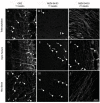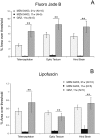Large differences in aging phenotype between strains of the short-lived annual fish Nothobranchius furzeri
- PMID: 19052641
- PMCID: PMC2585814
- DOI: 10.1371/journal.pone.0003866
Large differences in aging phenotype between strains of the short-lived annual fish Nothobranchius furzeri
Abstract
Background: A laboratory inbred strain of the annual fish Nothobranchius furzeri shows exceptionally short life expectancy and accelerated expression of age markers. In this study, we analyze new wild-derived lines of this short-lived species.
Methodology/principal findings: We characterized captive survival and age-related traits in F1 and F2 offspring of wild-caught N. furzeri. Wild-derived N. furzeri lines showed expression of lipofuscin and neurodegeneration at age 21 weeks. Median lifespan in the laboratory varied from to 20 to 23 weeks and maximum lifespan from 25 to 32 weeks. These data demonstrate that rapid age-dependent decline and short lifespan are natural characteristics of this species. The N. furzeri distribution range overlaps with gradients in altitude and aridity. Fish from more arid habitats are expected to experience a shorter survival window in the wild. We tested whether captive lines stemming from semi-arid and sub-humid habitats differ in longevity and expression of age-related traits. We detected a clear difference in age-dependent cognitive decline and a slight difference in lifespan (16% for median, 15% for maximum lifespan) between these lines. Finally, we observed shorter lifespan and accelerated expression of age-related markers in the inbred laboratory strain compared to these wild-derived lines.
Conclusions/significance: Owing to large differences in aging phenotypes in different lines, N. furzeri could represent a model system for studying the genetic control of life-history traits in natural populations.
Conflict of interest statement
Figures










References
-
- Austad SN. On Herrera and Jagadeeswaran's “Annual fish as a genetic model for aging”. J Gerontol A Biol Sci Med Sci. 2004;59:99–100. - PubMed
-
- Genade T, Benedetti M, Terzibasi E, Roncaglia P, Valenzano DR, et al. Annual fishes of the genus Nothobranchius as a model system for aging research. Aging Cell. 2005;4:223–233. - PubMed
-
- Levels PJ, Gubbels RE, Denuce JM. Oxygen consumption during embryonic development of the annual fish Nothobranchius korthausae with special reference to diapause. Comp Biochem Physiol A. 1986;84:767–770. - PubMed
-
- Podrabsky JE, Hand SC. The bioenergetics of embryonic diapause in an annual killifish, austrofundulus limnaeus. J Exp Biol. 1999;202(Pt 19):2567–2580. - PubMed
-
- Hoback WW, Podrabsky JE, Higley LG, Stanley DW, Hand SC. Anoxia tolerance of con-familial tiger beetle larvae is associated with differences in energy flow and anaerobiosis. J Comp Physiol [B] 2000;170:307–314. - PubMed
Publication types
MeSH terms
LinkOut - more resources
Full Text Sources
Medical
Miscellaneous

